Abstract
This research aims to explore natural and organic sources of plant bio-stimulant such as moringa leaf extract (MLE) and endophytic bacteria isolated from moringa roots to promote seed germination and seedling growth of chilli. Various extraction methods using methanol, ethanol and distilled water were compared to select the best extraction method based on phytochemical properties that could help to alleviate abiotic stresses and enhance root growth. Pre-screened endophytic bacteria with plant growth-promoting traits were also tested for their ability to increase the growth of chilli seedlings. The effects of moringa leaf extract and endophytic bacteria as bio-stimulants on chilli seedlings were determined using plant physiological analyses.
1. Introduction
The growth and productivity of plants mainly depend on the available nutrients and their uptake by plant roots. Bio-stimulant could amend a plant’s physiological processes to improve the nutrient absorption and optimize its consumption [1]. Research on the potential new sources of plant bio-stimulant to increase crop yield and quality despite of environmental stresses has gained wide attention recently. Plant bio-stimulant that boosts nutrient absorption and nutrient use efficiency could also help to reduce the excess application of mineral fertilizers [2,3].
Moringa is a nutrient-rich plant with antioxidants [4] and naturally occurring cytokinin and zeatin [5]. It has been a research priority in recent years as it could show promising results on seed germination, nutrient use efficiency, plant growth and yield under abiotic stress and improved the quality of post-harvest [6,7,8]. Endophytes are considered superior to rhizobacteria and could exhibit their beneficial activity more directly in the host compared to rhizobacteria [9,10].
In this study, the effects of moringa leaf extract and moringa roots’ endophytic bacteria were tested on chilli seedlings. Different extraction methods were compared to select the most efficient moringa leaf extract that could promote the growth of chilli seedlings. This study is aimed to find potential organic plant bio-stimulant for chilli cultivation. Organic plant bio-stimulant plays a vital role in the advancement of safe and sustainable agriculture practice.
2. Materials and Methods
2.1. Isolation and of Endophytes
Endophytic bacterium was isolated from Moringa oleifera roots. The roots were collected and stored at 10 °C until use. The soil attached to the roots was removed by washing with tap water. The roots were cut into small pieces and 1 g of roots was weighed in a conical flask filled up with sterile distilled water. The conical flasks were shaken at high speed for 30 min to remove the remaining soil attached to the root tips and rinsed a few times until the sterile water remained clear. Then, the roots were macerated using a sterile pestle and mortar and put into 9 mL of sterile distilled water and mixed for 30 min at 100 rpm. To check the sterilization efficiency, sterile water from the final rinsing before maceration was inoculated on nutrient agar to ensure no bacterial growth. After 30 min, 1 mL from the root maceration solution was subjected to a serial dilution until 103 and spread onto nutrient agar and potato dextrose agar. The agar medium was incubated at room temperature for 48 h. The bacteria that grew on the medium were sub-cultured until a pure colony was obtained. The bacterial culture was tested for qualitative test for beneficial plant growth-promoting activities such as indole acetic acid, phosphorus solubilization, chitinase production and siderophore production using agar medium. The endophytic bacteria with the most potential, MR13, was selected for further experiment. A pure colony of MR13 was cultured in potato dextrose broth for 48 h at 80 rpm. Then, bacterial culture was transferred to a falcon tube and centrifuged at 10,000 rpm for 15 min. The pellet was washed with sterile distilled water and diluted with 30 mL of sterile distilled water. The bacterial culture was used as bacterial treatment for the chilli seedlings.
2.2. Moringa Leaf Extraction
Healthy and matured moringa leaves were collected and washed. The extraction process was carried out using both dry (DL)and fresh leaves (FL). Leaves were dried in hot oven at 40 °C for 3 days. After drying, the leaves were crushed and ground using a blender. The ground powder was sieved with 0.5 mm mesh size sieve. Fresh leaves that were collected one day earlier were kept at 10 °C and used the next day. Three extraction methods were used in this study namely maceration, infusion and decoction. The solvents used were distilled water, 50% ethanol v/v and 50% methanol v/v. For maceration, 10 g of dry leaf sample and 35 g of fresh leaf were mixed with 450 mL of solvent and left in a shaker for 72 h at100 rpm. Fresh leaves were homogenized using a mortar and pestle before extraction. The extract was filtered using muslin cloth and the marc was re-extracted by the same process and solvent until the extraction was exhausted. The solvents such as ethanol and methanol were evaporated using rotary evaporator. The remaining balance after evaporation process was collected and stored at −20 °C until further use. For the infusion method, distilled water (50°), cold methanol (50%) and cold ethanol (50%). About 10 g of dry leaf sample and 35 g of fresh leaf sample were mixed with 450 mL of solvent and left for 72 h at room temperature. The extract was filtered and the marc was re-extracted by the same process and solvent until the extraction was exhausted. The solvents such as ethanol and methanol were evaporated using a rotary evaporator. The remaining balance after evaporation process was collected and stored at −20 °C until further use. For the decoction method, 10 g of dry leaf sample and 35 g of fresh leaf sample were boiled with 450 mL of distilled water for 30 min and left overnight. The extract was filtered using muslin cloth and stored at −20 °C until further use. The treatments used in this experiment were described in Table 1.

Table 1.
Moringa leaf extraction methods.
2.3. Phyto-Chemistry Analyses
Water based treatments were centrifuged at 12,000× g for 20 min and the supernatant was collected and stored at −20 °C. For treatments with solvent, centrifuged at 12,000× g for 20 min and the supernatant was collected and was kept in a water bath set at 40 °C for three days before drying using a rotary evaporator. The balance solution after evaporation was stored at −20 °C until further analysis.
2.3.1. Phenolic Content
Test tubes containing 100 µL of plant extract, 500 µL of water and 100 µL of Folin–Ciocalteu reagent were prepared in triplicates. The mixture was allowed to stand for 6 min before adding 1 mL of sodium carbonate solution (7.5% w/v) and 500 µL of water. Then, the tubes were kept in dark room at RT for 30 min. Absorbance was recorded against a reagent blank at 760 nm using a UV-Vis spectrometer after 30 min of incubation in a dark room. Total phenolic content was calculated using the standard calibration curve of gallic acid in methanol and expressed as mg gallic acid equivalent/g.
2.3.2. Total Flavonoids
Plant extract (100 µL) was mixed with 500 µL of distilled water and then with 100 µL of 5% of sodium nitrate in the test tubes and allowed to stand for 6 min. Then, 150 µL of 10% aluminum chloride solution was added and allowed to stand for 5 min and finally 200 µL of 1 M sodium hydroxide was added. The absorbance of the samples was measured at 510 nm using a UV-Vis spectrometer. All reagents contained blanks except AlCI3 which was replaced with distilled water. The results were calculated using the standard calibration curve of quercetin in methanol and expressed as quercetin equivalents (mg/g).
2.3.3. Free Radical Scavenging Activity of 2,2-Diphenyl-1-picryl-1-phenyl-hydrazyl-hydrate (DPPH)
A fresh 0.02% DPPH solution was prepared in methanol. In total, 50 µL of moringa leaf extract and 3 mL of DPPH solution were added to a test tube and mixed vigorously. It was allowed to stand in the dark at 37 °C for 30 min. The decrease in the absorbance was measured in each solution at 517 nm using a UV-Vis spectrometer. A standard graph was prepared using gallic acid of different concentrations. A blank was prepared without gallic acid. The concentration of the sample required to scavenge 50% of DPPH was determined from the curve of percentage inhibition. Free radical scavenging activity was calculated using the formula below.
2.4. Seedlings Growth
Chilli seeds were pre-germinated in sterile water and transferred into a seedling tray filled with peat moss. It was left to grow for about one week or until 2–4 leaves emerged from the seedlings. Then, 2 mL of the moringa leaf extract (T1–T14), MR13 (endophytic bacteria) and distilled water (control) were applied to the peat moss. Every treatment was applied once every two weeks with five replications. Thirty days after seed germination, the seedlings were subjected to plant physiology analyses such as seedling height, total root length, total root surface area, relative chlorophyll content and root shoot ratio.
2.4.1. Root Length and Root Surface Area
Epson Flatbed Scanner (EPSON Expression 11000XL 1.8 V3.49 3.49, Regent Instruments Inc., Quebec, Canada) was used to measure the total root length and total root surface area. Chilli roots were washed thoroughly in tap water to remove the soil debris prior to imaging the roots in Epson Flatbed root scanner.
2.4.2. Relative Chlorophyll Content
Relative chlorophyll content was measured using SPAD-502 chlorophyll meter (SPAD 502, Minolta-Camera Co., Osaka, Japan). The data points were recorded at five positions along the leaf blade and then the data points were averaged as a single value.
2.4.3. Plant Height and Root: Shoot Ratio
Seedling heights were measured from the collar of the stem to the highest leaf. The roots and shoots were separated, washed and dried in an oven at 70 °C for 3 days before measuring the dry weight of the root biomass and dry weight of the shoot biomass.
3. Results and Discussion
Medicinal plants are rich with antioxidants which could alleviate environmental stresses and lead to plant growth. Among all the extraction methods, the antioxidant properties such as phenols, flavonoids and DPPH radical scavenging activities of moringa leaf extract of various extraction methods revealed that apart from polar solvents that are commonly used for the extraction of antioxidant compounds, water extraction also shows considerable antioxidant activities (Table 2). IC50 value is used to indicate the antioxidant capacity where the concentration of the sample that causes 50% reduction in the initial DPPH concentration was calculated based on a linear regression graph (not shown) of the mean percentage of antioxidant activity against the concentration of gallic acid (µg/mL). The range of DPPH radical scavenging activity is 26.41–73.96 µg/mL. The lowest free radical scavenging activity was recorded by the maceration of the fresh moringa leaves. All the other extraction methods exhibited more than 50% free radical scavenging activity which corresponds to more than 8.39 µL/mL of DPPH concentration. Polar solvent extractions using methanol and ethanol have shown better antioxidant activities compared to water extraction. However, the water extraction of fresh moringa leaf extract via the infusion method (T12) at 50 °C was comparable to the polar solvent extraction method. The total phenolic content in all the extraction methods ranged between 0.16–0.72 gallic acid equivalent (GAE) mg/L while total flavonoid content ranged from between 0.25–75.44 quercetin equivalent mg/mL. Methanol extraction using the maceration method (T1) showed the highest phenolic content and water extraction using the infusion method (T9) showed the lowest phenolic content. Extraction methods using ethanol (T11) and water (T3) exhibited high flavonoid content followed by cold methanol infusion (T10) and water boiling of fresh leaves (T14). The lowest flavonoid content was observed in treatment T4 (maceration using methanol) and T12 (water infusion at 50 °C). In general, fresh leaf extraction has recorded high flavonoid content except for sample T3 and high DPPH free radical scavenging activity except for samples T7 and T8. Dry leaf extraction showed high phenolic content.

Table 2.
Phytochemical analyses of moringa leaf juice extracted via various methods.
The plant growth parameters such as relative chlorophyll content, seedling height, total root length, total root surface area and the root to shoot ratio were measured for moringa leaves of various extraction methods, endophytic bacteria and control. Relative chlorophyll content is a non-destructive and indirect method that indicates the health and nutritional status of the plant. The relative chlorophyll content was not significant among treatments except for T7 (cold methanol infusion of dry leaves) and T9 (water infusion of dry leaves at 50 °C) (Figure 1). Plant height was significantly higher in all treatments compared to the control, particularly in sample T1 (methanol maceration of dry leaves) and T6 (water maceration of fresh leaves). The seedling heights ranged between 12.1 cm and 16.5 cm (Figure 2). Total root length and total root surface area are important indicators that could show the direct effect of bio-stimulant on chilli seedlings. Total root surface measurements were comparable among all the treatments (Figure 3). Root length and proliferation root hairs could enhance nutrient absorption and nutrient use efficiency. The highest root length was observed in sample T2 (dry leaves of ethanol extraction), T10 (fresh leaves of methanol extraction), T8 (dry leaves of ethanol extraction), T9 (dry leaves of water extraction) and MR13 (endophytic bacteria) (Figure 4). Root/shoot ratio is a vital criterion for assessing plant health. Samples T13 (water extraction of dry leaves by boiling method) and T4 (methanol extraction of fresh leaves by maceration method) showed the highest root/shoot ratio (Figure 5).
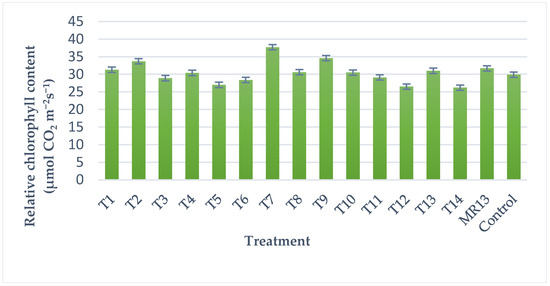
Figure 1.
Relative chlorophyll content of chilli seedlings treated with endophytic bacteria and moringa leaf extract using various extraction methods. The values are an average of five independent measurements.
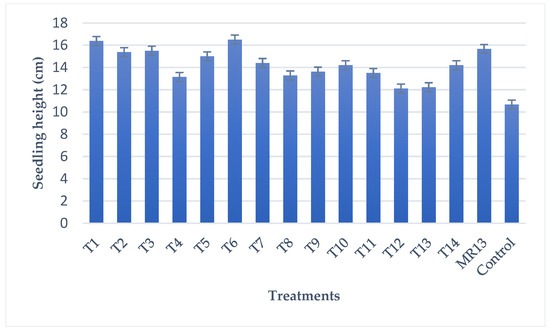
Figure 2.
The height of chilli seedlings treated with endophytic bacteria and moringa leaf extract using various extraction methods. The values are an average of five independent measurements.
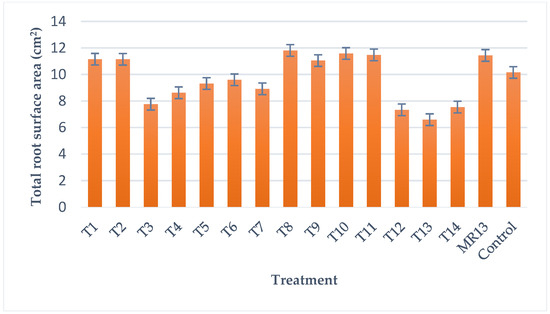
Figure 3.
Total root surface area of chilli seedlings treated with endophytic bacteria and moringa leaf extract using various extraction methods. The values are an average of five independent measurements.
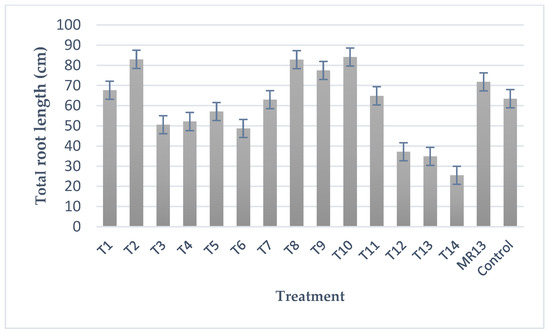
Figure 4.
The root length of chilli seedlings treated with endophytic bacteria and moringa leaf extract using various extraction methods. The values are an average of five independent measurements.
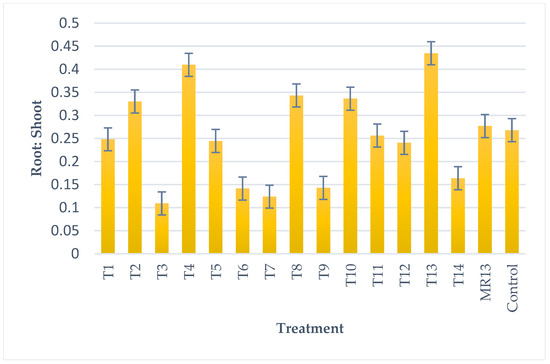
Figure 5.
The root to shoot ratio of chilli seedlings treated with endophytic bacteria and moringa leaf extract using various extraction methods. The values are an average of five independent measurements.
4. Conclusions
This study has revealed that apart from methanol and ethanol extraction, water extraction, which is a cheap and feasible method of moringa leaf extraction, could be used for the production of an organic bio-stimulant for chilli seedlings. Moringa leaves were not only rich with antioxidant contents but could also enhance the health and root growth of chilli for better nutrient use efficiency. Endophytic bacteria also have the potential to be utilized as a plant bio-stimulant as their efficiency in improving chilli seedling growth is comparable to moringa leaf extract.
Author Contributions
Conceptualization, S.M, A.A., Y.S. and C.V.S.; methodology, S.M.; software, A.A.; validation, A.A., Y.S. and C.V.S.; formal analysis, S.M.; investigation, S.M.; resources, A.A.; data curation, S.M.; writing—original draft preparation, S.M.; writing—review and editing, S.M., A.A., Y.S. and C.V.S.; visualization, S.M.; supervision, A.A., Y.S. and C.V.S.; project administration, A.A.; funding acquisition, A.A. All authors have read and agreed to the published version of the manuscript.
Funding
This research received no external funding.
Institutional Review Board Statement
Not applicable.
Informed Consent Statement
Not applicable.
Data Availability Statement
Not applicable.
Acknowledgments
We would like to acknowledge the Malaysian Agriculture Research and Development Institute for the PhD scholarship.
Conflicts of Interest
The authors declare no conflict of interest.
References
- Kapur, B.; Ali, M.; Celiktopuz, E.; Kafkas, E.; Payda, S. Health and Taste Related Compounds in Strawberries under Various Irrigation Regimes and Bio-Stimulant Application. Food Chem. 2018, 263, 67–73. [Google Scholar] [CrossRef] [PubMed]
- Chanda, M.; Merghoub, N.; El Arroussi, H. Microalgae Polysaccharides: The New Sustainable Bioactive Products for the Development of Plant Bio-Stimulants? World J. Microbiol. Biotechnol. 2019, 35, 177. [Google Scholar] [CrossRef] [PubMed]
- Bulgari, R.; Cocetta, G.; Trivellini, A.; Vernieri, P.; Ferrante, A. Biostimulants and Crop Responses: A Review. Biol. Agric. Hortic. 2015, 31, 1–17. [Google Scholar] [CrossRef]
- Jang, S.J.; Kuk, Y.I. Mechanism of Crop Growth Promotion and Responses to Various Environmental Stresses with Different Plant Extracts. Ital. J. Agron. 2019, 14, 230–239. [Google Scholar] [CrossRef]
- Jhilik, N.; Hoque, T.; Moslehuddin, A.; Abedin, M. Nutritional Improvement of Wheat by Foliar Application of Moringa Leaf Extract. Fundam. Appl. Agric. 2018, 4, 565. [Google Scholar] [CrossRef]
- Shah, F.M.; Razaq, M.; Ali, A.; Han, P.; Chen, J. Comparative Role of Neem Seed Extract, Moringa Leaf Extract and Imidacloprid in the Management of Wheat Aphids in Relation to Yield Losses in Pakistan. PLoS ONE 2017, 12, e0184639. [Google Scholar] [CrossRef] [PubMed] [Green Version]
- Howladar, S.M. A Novel Moringa Oleifera Leaf Extract Can Mitigate the Stress Effects of Salinity and Cadmium in Bean (Phaseolus vulgaris L.) Plants. Ecotoxicol. Environ. Saf. 2014, 100, 69–75. [Google Scholar] [CrossRef] [PubMed]
- Abd El-Mageed, T.A.; Semida, W.M.; Rady, M.M. Moringa Leaf Extract as Biostimulant Improves Water Use Efficiency, Physio-Biochemical Attributes of Squash Plants under Deficit Irrigation. Agric. Water Manag. 2017, 193, 46–54. [Google Scholar] [CrossRef]
- Santoyo, G.; Moreno-Hagelsieb, G.; del Carmen Orozco-Mosqueda, M.; Glick, B.R. Plant Growth-Promoting Bacterial Endophytes. Microbiol. Res. 2016, 183, 92–99. [Google Scholar] [CrossRef] [PubMed]
- Papik, J.; Folkmanova, M.; Polivkova-Majorova, M.; Suman, J. The Invisible Life inside Plants: Deciphering the Riddles of Endophytic Bacterial Diversity. Biotechnol. Adv. 2020, 44, 107614. [Google Scholar] [CrossRef] [PubMed]
Publisher’s Note: MDPI stays neutral with regard to jurisdictional claims in published maps and institutional affiliations. |
© 2022 by the authors. Licensee MDPI, Basel, Switzerland. This article is an open access article distributed under the terms and conditions of the Creative Commons Attribution (CC BY) license (https://creativecommons.org/licenses/by/4.0/).